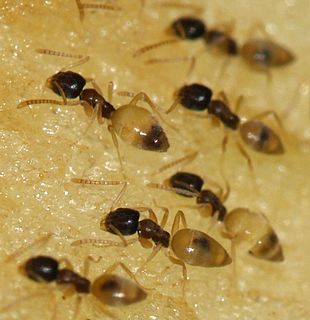
Dorylus, also known as driver ants, safari ants, or siafu, is a large genus of army ants found primarily in central and east Africa, although the range also extends to southern Africa and tropical Asia. The term siafu is a loanword from Swahili, and is one of numerous similar words from regional Bantu languages used by indigenous peoples to describe various species of these ants. Unlike the New World members of the former subfamily Ecitoninae, members of this genus do form temporary anthills lasting from a few days up to three months. Each colony can contain over 20 million individuals. As with their New World counterparts, there is a soldier class among the workers, which is larger, with a very large head and pincer-like mandibles. They are capable of stinging, but very rarely do so, relying instead on their powerful shearing jaws.

Dolichoderinae is a subfamily of ants, which includes species such as the Argentine ant, the erratic ant, the odorous house ant, and the cone ant. The subfamily presents a great diversity of species throughout the world, distributed in different biogeographic regions, from the Palearctic, Nearctic, Afrotropical region and Malaysia, to the Middle East, Australian, and Neotropical regions.

Tapinoma is a genus of ants that belongs to the subfamily Dolichoderinae. The genus currently comprises 74 described species distributed worldwide in tropical and temperate regions. Members of are generalized foragers, nesting in a wide variety of habitats, ranging from grasslands, open fields, woodlands, to inside buildings. The majority of species nest in the ground under objects such as stones or tree logs, other species build nests under bark of logs and stumps, in plant cavities, insect galls or refuse piles.

Dorymyrmex is a genus of ants in the subfamily Dolichoderinae.

The wildlife of Tunisia is composed of its flora and fauna. It has 84 species of mammals and 375 species of birds. Tunisia is well documented for its addax and Dama Gazelle population.

Aphaenogaster is a genus of myrmicine ants. About 200 species have been described, including 18 fossil species. They occur worldwide except in South America south of Colombia, Sub-Saharan Africa, and Antarctica.

Aenictus is a large army ant genus distributed in the Old World tropics and subtropics. It contains about 181 species, making it one of the larger ant genera of the world.

Cataulacus is a genus of ants in the subfamily Myrmicinae. The genus is distributed in the Paleotropical regions, mainly in the Afrotropics. Most species are found in forests, but a few are known from more open and arid habitats.
Bothriomyrmex breviceps is a species of ant in the genus Bothriomyrmex. Described by Santschi in 1919, the species is endemic to Tunisia.
Bothriomyrmex communistus is a species of ant in the genus Bothriomyrmex. Described by Santschi in 1919, the species is endemic to various countries of Europe and Asia, including Albania, Armenia, Bulgaria, Czech Republic, Georgia, Greece, Italy, Montenegro, Slovenia and Ukraine.
Bothriomyrmex corsicus is a species of ant in the genus Bothriomyrmex. Described by Santschi in 1923, the species is endemic to various European countries, including Austria, Bulgaria, Czech Republic, France, Greece, Italy, Liechtenstein, Monaco, Montenegro, Romania, Slovakia, Spain, Switzerland, Ukraine.
Bothriomyrmex crosi is a species of ant in the genus Bothriomyrmex. Described by Santschi in 1919, the species is endemic to Algeria.
Bothriomyrmex cuculus is a species of ant in the genus Bothriomyrmex. Described by Santschi in 1919, the species is endemic to Algeria and Tunisia.
Bothriomyrmex emarginatus is a species of ant in the genus Bothriomyrmex. Described by Santschi in 1911, the species is endemic to Tunisia.
Bothriomyrmex pubens is a species of ant in the genus Bothriomyrmex. Described by Santschi in 1919, the species is endemic to Algeria and Tunisia.
Bothriomyrmex regicidus is a species of ant in the genus Bothriomyrmex. Described by Santschi in 1919, the species is endemic to Algeria and Tunisia.

Bothriomyrmex saundersi is a species of ant in the genus Bothriomyrmex. Described by Santschi in 1922, the species is endemic to Portugal and Spain.
Tapinoma aberrans is a species of ant in the genus Tapinoma. Described by Santschi in 1911, the species is endemic to Madagascar.

Tapinoma subtile is a species of ant in the genus Tapinoma. Described by Santschi in 1911, the species is endemic to various countries in Africa.











